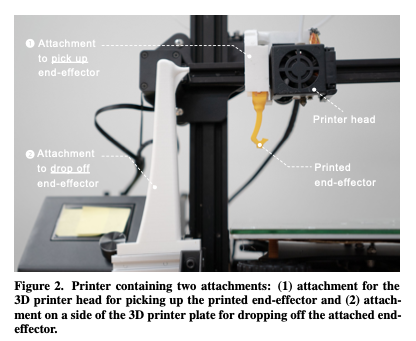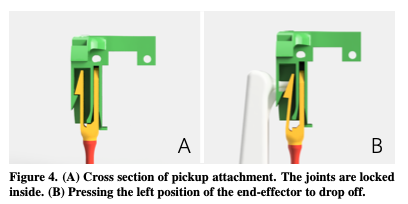Talk about 4D printing! Researchers from Meiji University in Japan, Yuto Kuroki and Keita Watanabe, have developed a unique system for 3D printing and then assembling and operating a variety of robotic assemblies. Dubbed the Functgraph, the system 3D prints a series of parts, including end effectors that are then used to build and operate equipment for specific tasks. This includes everything from making a sandwich and folding clothing to printing and packaging figurines.
Building off an earlier paper on the subject, the researchers presented their concept at the Conference on 4D and Functional Fabrication 2020, describing Functgraph as a means of utilizing a traditional fused filament fabrication (FFF) 3D printer for “personal factory automation”. As demonstrated in the video below, the Functgraph process first 3D prints all of the necessary parts for a given application. It then uses a tool attached to the print head to move parts around the bed, swapping the end effectors on this tool depending on the task required, and assembling and positioning all of the printed components to execute the programmed operation: making a ham and cucumber sandwich, folding a shirt, packaging 3D printed rabbits, or assembling a toy car.
The system consists of a CR-10 3D printer from Creality modified with a system near the extruder to grab a 3D printed end effector, as well as a tower on the side of the machine for depositing end effectors when no longer needed. The end effector pickup system relies on a barb that attaches to the end effector by pressing down on it and clicking it into place. Once the end effector is connected, it is used to move the various 3D printed parts on the bed and assembling them into place. The end effectors include specialty hooks for breaking away supports, folding printed parts, or moving parts.
In addition to using a cheap, accessible printer, the authors relied on ordinary materials and print settings: polylactic acid (PLA), a glass build plate, build plate temperature of 60◦C, extruder temperature of 200◦C. The key to Functgraph, then, is the design. In particular, the researchers place support structures at key points to maximize peeling off of the print bed, while also using precautions to ensure the material adheres to the bed during the fabrication process. For proper adherence, the extruder is actually closer to the printbed than it would be normally.
In some cases, such as when printing springs, it was necessary to have an end effector used to break support structures. The authors noted in their earlier paper:
“In order to solve this problem, we design a brittle support structure (Figure 12) and the end-effector that break this support (Figure 11A). The support structures are broken by pushing them from top to bottom. The reason is that the 3D printer can deliver large forces in the Z direction, and the probability that the printed object is peeled off during the operation is lower than applied from the X or Y direction. This end-effector is thick and long because it has to push the support structure without colliding with the printed object.
“The support material is in the form of a slope of approximately 45 degrees, as illustrated in Figure 13A. This support is print- able without the usual support structure. Ideally, the support material flies without being left in place. Therefore, by conducting trial and error with stress simulation, an almost ideal fracture could be realized (Figure 13B).
First author Kuroki Yuto explains the motivation behind the project in the description of a YouTube video, saying:
“Through the trial production of these applications, we thought that Functgraph’s strength was ‘the ability for users to physically achieve their goals without intervention.’ As I mentioned earlier, no expertise, no specialized machines, no human hands are required, and users can achieve their goals simply by downloading the app and playing it on a 3D printer. We thought of this as Personal Factory Automation (Personal Fabrication + Factory Automation). With Functgraph, 3D printers can aim for the future as a new platform that downloads apps like smartphones and provides physical support in the real world.”
By 3D printing multiple rabbit figurines and then placing them in their packaging, the team demonstrate the possibilities for automated manufacturing and production. They suggest that full color printing could make the object itself more interesting, as well as the packaging. As for the 3D printed car, Kuroki Yuto has even bigger ideas: 3D printing a vehicle on the moon.
The reason for making this app as a prototype is a strange story, but from the idea that if you send a 3D printer to a remote place like space, it will generate what you need on the spot, then exploration I chose a car because I wanted a car to do. At present, it does not run on its own, but I think that it will be necessary to load a battery if it is made more, but I think that it can run. Even if you search the moon and your car breaks, I think that you can procure it on the spot again if you have a 3D printer, even if you do not have specialized knowledge, dedicated machines, or even human hands.
This is certainly an interesting idea for the many projects exploring the possibilities of 3D printing habitats in space. As for the Earthlier applications, one wonders if the wasted energy and materials for such automated tasks make up for any time and energy savings on the part of the user. Perhaps if the materials were fully biodegradable or reusable and it ran on its own wind power, it could be worth it? Either way, while I am folding my own laundry, these researchers are paving the way for truly self-replicating RepRaps.
Subscribe to Our Email Newsletter
Stay up-to-date on all the latest news from the 3D printing industry and receive information and offers from third party vendors.
You May Also Like
3D Printing News Briefs, April 27, 2024: Research, Digital Dentistry, Cycling, & More
We’re starting today’s 3D Printing News Briefs with some research into 3D printed luminescent quantum-dot polymer architectures and free-form laser beam shaping, and then on to an open source 4-axis...
HP & INDO-MIM Collaborate to Boost Metal 3D Printing in India
HP Inc. and INDO-MIM, a US- and India-based supplier of metal injection molding (MIM) powders and contract manufacturer, have announced that the two companies will collaborate to accelerate additive manufacturing...
3D Printing News Briefs, February 17, 2024: Shot Blasting, Service Bureaus, & More
In today’s 3D Printing News Briefs, we’re starting out with post-processing, as SKZ Würzburg is using a shot blast system from AM Solutions for its research. Moving on to business,...
3D Printing News Unpeeled: Not That Kind of Organ 3D Printing
GKN Aerospace will create a 150 jobs in Trollhattan Sweden with an investment of $60 million part of which comes from the Swedish Energy Agency’s Industriklivet initiative. The investment will...

































